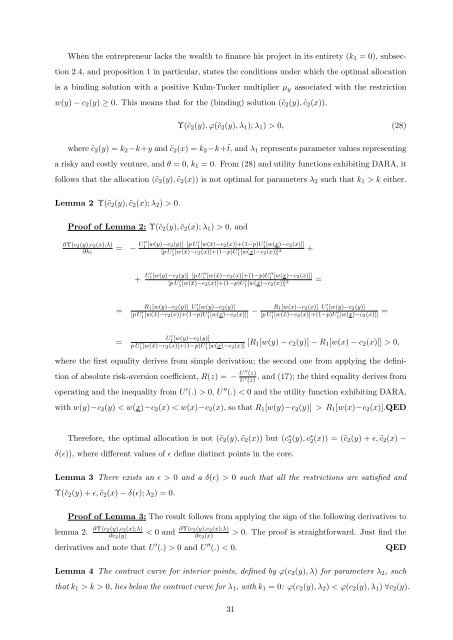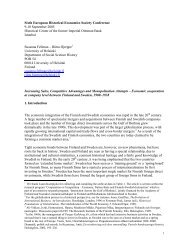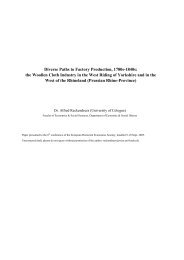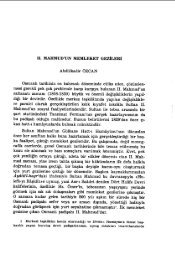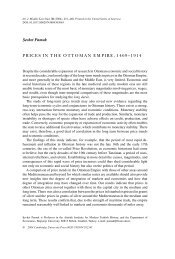The Birth of Insurance Contracts - The Ataturk Institute for Modern ...
The Birth of Insurance Contracts - The Ataturk Institute for Modern ...
The Birth of Insurance Contracts - The Ataturk Institute for Modern ...
Create successful ePaper yourself
Turn your PDF publications into a flip-book with our unique Google optimized e-Paper software.
When the entrepreneur lacks the wealth to finance his project in its entirety (k1 = 0), subsec-<br />
tion 2.4, and proposition 1 in particular, states the conditions under which the optimal allocation<br />
is a binding solution with a positive Kuhn-Tucker multiplier µy associated with the restriction<br />
w(y) − c2(y) ≥ 0. This means that <strong>for</strong> the (binding) solution (˜c2(y), ˜c2(x)),<br />
Υ(˜c2(y), ϕ(˜c2(y), λ1); λ1) > 0, (28)<br />
where ˜c2(y) = k2−k+y and ˜c2(x) = k2−k+˜t, and λ1 represents parameter values representing<br />
a risky and costly venture, and θ = 0, k1 = 0. From (28) and utility functions exhibiting DARA, it<br />
follows that the allocation (˜c2(y), ˜c2(x)) is not optimal <strong>for</strong> parameters λ2 such that k1 > k either.<br />
Lemma 2 Υ(˜c2(y), ˜c2(x); λ2) > 0.<br />
Pro<strong>of</strong> <strong>of</strong> Lemma 2: Υ(˜c2(y), ˜c2(x); λ1) > 0, and<br />
∂Υ(c2(y),c2(x);λ)<br />
∂k1<br />
= −<br />
=<br />
=<br />
U ′′<br />
1 [w(y)−c2(y)] [p U ′ 1 [w(¯x)−c2(x)]+(1−p)U ′ 1 [w(x)−c2(x)]]<br />
[p U ′ 1 [w(¯x)−c2(x)]+(1−p)U ′ 1 [w(x)−c2(x)]] 2 +<br />
+ U ′ 1 [w(y)−c2(y)] [p U ′′<br />
1 [w(¯x)−c2(x)]+(1−p)U ′′<br />
1 [w(x)−c2(x)]]<br />
[p U ′ 1 [w(¯x)−c2(x)]+(1−p)U ′ 1 [w(x)−c2(x)]] 2 =<br />
R1[w(y)−c2(y)] U ′ 1 [w(y)−c2(y)]<br />
[p U ′ 1 [w(¯x)−c2(x)]+(1−p)U ′ R1[w(x)−c2(x)] U<br />
1 [w(x)−c2(x)]] −<br />
′ 1 [w(y)−c2(y)]<br />
[p U ′ 1 [w(¯x)−c2(x)]+(1−p)U ′ 1 [w(x)−c2(x)]] =<br />
U ′ 1 [w(y)−c2(y)]<br />
p U ′ 1 [w(¯x)−c2(x)]+(1−p)U ′ 1 [w(x)−c2(x)] [R1[w(y) − c2(y)] − R1[w(x) − c2(x)]] > 0,<br />
where the first equality derives from simple derivation; the second one from applying the defini-<br />
tion <strong>of</strong> absolute risk-aversion coefficient, R(z) = − U ′′ (z)<br />
U ′ (z) , and (17); the third equality derives from<br />
operating and the inequality from U ′ (.) > 0, U ′′ (.) < 0 and the utility function exhibiting DARA,<br />
with w(y)−c2(y) < w(x)−c2(x) < w(x)−c2(x), so that R1[w(y)−c2(y)] > R1[w(x)−c2(x)].QED<br />
<strong>The</strong>re<strong>for</strong>e, the optimal allocation is not (˜c2(y), ˜c2(x)) but (c ∗ 2 (y), c∗ 2 (x)) = (˜c2(y) + ɛ, ˜c2(x) −<br />
δ(ɛ)), where different values <strong>of</strong> ɛ define distinct points in the core.<br />
Lemma 3 <strong>The</strong>re exists an ɛ > 0 and a δ(ɛ) > 0 such that all the restrictions are satisfied and<br />
Υ(˜c2(y) + ɛ, ˜c2(x) − δ(ɛ); λ2) = 0.<br />
Pro<strong>of</strong> <strong>of</strong> Lemma 3: <strong>The</strong> result follows from applying the sign <strong>of</strong> the following derivatives to<br />
lemma 2. ∂Υ(c2(y),c2(x);λ)<br />
∂c2(y)<br />
< 0 and ∂Υ(c2(y),c2(x);λ)<br />
∂c2(x)<br />
> 0. <strong>The</strong> pro<strong>of</strong> is straight<strong>for</strong>ward. Just find the<br />
derivatives and note that U ′ (.) > 0 and U ′′ (.) < 0. QED<br />
Lemma 4 <strong>The</strong> contract curve <strong>for</strong> interior points, defined by ϕ(c2(y), λ) <strong>for</strong> parameters λ2, such<br />
that k1 > k > 0, lies below the contract curve <strong>for</strong> λ1, with k1 = 0: ϕ(c2(y), λ2) < ϕ(c2(y), λ1) ∀c2(y).<br />
31


